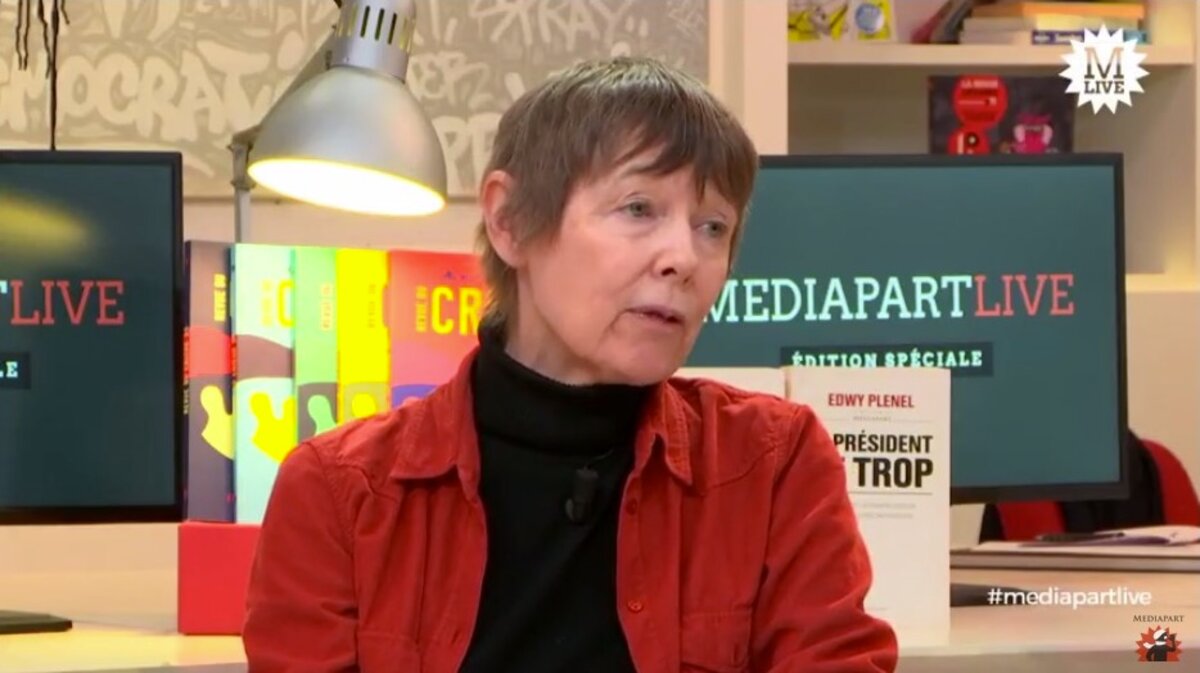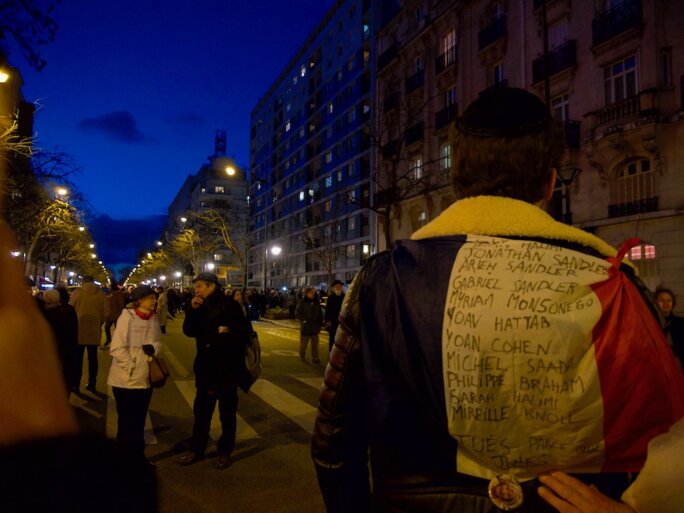The number of reported crimes of anti-Semitism in France rose to 541 in 2018, compared to 311 in 2017, a year-on-year rise of 74%. The 2018 figures, which followed a two-year fall in reported incidents targeting Jews, included the stabbing murder in Paris of an 85-year-old widow, Mireille Knoll, and 80 assaults, some of them attempted murders, 358 threats of violence, and 102 incidents of attacks on properties, prompting interior minister Christophe Castaner to comment earlier this month that, “Anti-Semitism is spreading like poison”.
The most recent incidents include the desecration of a memorial to Ilan Halimi, a 23-year-old Jewish man who was kidnapped, tortured and murdered because of his origins, the daubing of swastikas on postboxes in Paris decorated with portraits of the late politician Simone Veil, a Holocaust survivor, and the spray-painting of “Juden” (German for “Jews”) on a bagel bakery in the capital.
On Saturday, controversial French essayist and commentator Alain Finkielkraut, a Jew, was filmed being verbally abused as a “dirty Zionist” by a small group on the sidelines of a demonstration by so-called ‘yellow vests’, members of the three-month movement of anti-government street protests against falling living standards among the lower-paid. Overnight Monday, tombs in a Jewish cemetery in eastern France were desecrated with painted swastikas.

Enlargement : Illustration 1

Prompted by Socialist Party leader Olivier Faure, a rally denouncing anti-Semitism was held in Paris on Tuesday evening, attended by leaders of most political parties (excluding the far-right which was not invited), and also Prime Minister Edouard Philippe and members of his government.
Separate rallies on Tuesday included one by the far-left NPA party and several Jewish organisations in north Paris, protesting anti-Semitic acts and their “instrumentalization”, and another by the far-right Rassemblement National (former Front National) which denounced the rise of “Islamist networks”, a favourite theme of the party whose founder and former leader, Jean-Marie Le Pen, has several convictions for anti-Jewish and negationist jibes.
For French political scientist Nonna Mayer, a specialist in anti-Semitism and an emeritus research director with France’s national scientific research centre, the CNRS, the latest peaks in ant-Semitic acts correspond with the heightening in violence of the Israeli-Palestinian conflict between March and July last year, and also with the advent of the ‘yellow vest’ protests that began in November and which have been latched onto by unbridled extremist groups. In this interview with Mediapart, she details the latent forms of anti-Semitism which, she argues, needs only a timely opportunity to erupt again, while she also sees a positive evolution of broad French public opinion in rejection of anti-Semitism.
-------------------------
Mediapart: What is the explanation for the 74% rise in 2018 of anti-Semitic acts reported to police and gendarmerie services?
Nonna Mayer: The number of anti-Semitic acts and threats is to be taken with precaution, because not all acts are reported, and do not always lead to the submission of a complaint. Above all, the figures must be put into perspective. Anti-Semitic acts and violence were residual at the end of the 1990s, climbing strongly when the second intifada broke out in 2000.
Since that date, the peaks in violence correspond with the Israeli interventions in the territories – 936 acts in 2002, 974 in 2004, 832 in 2009 – which were widely reported in the media and denounced. The latest peak corresponds with the Protective Edge operation in 2014, with 851 [editor’s note, anti-Semitic] acts [in France]. Having fallen since then, they rose again in 2018, with 541 acts compared to 311 the previous year. The [Middle East] conflict is in no way the cause, it is the trigger for those who, for one reason or another, identify themselves with the Palestinians and target French Jews who they assimilate with Israel and Zionism.

Enlargement : Illustration 2

Mediapart: Why was there such a peak after a two-year fall in reported incidents?
N.M.: From March to July 2018, an initial rise was observed, precisely linked to the conflict in the Middle East. It was the period of the “Great March of Return” [a series of Palestinian protests, referring to the reclaim of their former land, held along the Israeli border with the Gaza Strip that began on March 30th 2018], with the launching of burning kites and the controversy over the Israeli sniper action [which caused the deaths of at least 120 Palestinians, and the wounding of around 4,000 others].
The second peak, from November to December, corresponds with the ‘yellow vest’ movement. It is not anti-Semitic as such, but it is easily manipulated by extremist groups. All demonstrations are propitious to letting off steam, and whip up the excitable elements, the yellow vests more than others because of the eruptive, proliferate and unorganised nature of the movement. Above all, it is first and foremost a movement against the elites. Since his election, Emmanuel Macron has been the target of anti-Semitic caricatures, playing on his time at the Rothschild bank, an equation according to which ‘Macron equals Rothschild which equals big banks which equals Jews’.
Finally, it is a movement which first developed via the social media, which is propitious for the spreading of fake news, for anti-Semitic themes and conspiracy theories, in the lineage of the Protocols of the Elders of Zion.
If we take into account more distant causes, there is the context of social and economic insecurity since the 2008 crisis, which lends itself to the seeking of scapegoats. There is an always latent anti-Semitism, with arguments that have settled as a sediment over time, and which only needs the opportunity to rise back up to the surface. There is Christian anti-Judaism, which has it that Jews are a deicidal people; leftwing anti-Semitism – or the ‘socialism of imbeciles’, which assimilates Jews with the powers of finance and capitalism; there are the wild imaginings of the Nazis about inferior races.
The creation of Israel after WW II changed the image of Jews, no longer accused of being stateless but of having a ‘double allegiance’ – Israel before France. Then, after 1967 and the occupation of the Palestinian territories, came the idea that David had become Goliath, that the victims of yesterday were the executioners of today. Without forgetting either the rise of radical Islamism and of the jihad, making Jews the symbol par excellence of a hated Western world.
Mediapart: Opinion surveys by France’s National Consultative Commission on Human Rights, (CNCDH) show a structural rise in tolerance in French society since 1990, before this was interrupted between 2009 and 2014. How can the rise in anti-Semitic acts be explained against the backdrop of this greater tolerance?
N.M.: These criminal acts, of which we’ve seen the prompting mechanisms, nevertheless concern a minority of individuals, with 541 acts in 2018, of which a third concern violence in the true sense – attacks against people and property. One cannot generalise, they don’t reflect French public opinion, which evolves in counter-current to these acts, in the direction of a greater acceptance of French Jews – a minority who are the most accepted. In 1946, 36 percent of those questioned by [opinion pollster] Ifop felt that Jews were ‘French like the rest’, against 91 percent today. In the 1960s, some 40 percent thought that using phrases like ‘dirty Jew’ justified prosecution, and today the percentage is 86 percent. And a growing proportion, which is today around three-quarters, believe that a vigorous fight against anti-Semitism is necessary.
On the other hand, we can see the persistence of dangerous stereotypes, which assimilate Jews with money and power, and which fluctuate according to events in France, and not in the Middle East. The sentiment that ‘Jews have too much power’, which today concerns less than 20 percent of the population, was more than 33 percent in the years 1999-2000 when there was the debate over the reparations for spoliations suffered by Jews during WW II. That reached 37 percent in 2014, after the ban on public performances by [anti-Semitic comedian] Dieudonné and then the pro-Palestinian demonstrations. The sentiment that Jews have money is a deadly stereotype, which was behind the kidnapping and death of Ilan Halimi in 2006.
Mediapart: What did you think in reaction to the abuse shouted at Alain Finkielkraut on Saturday on the sidelines of a ‘yellow vest’ march, which appeared to draw on diverse anti-Semitic feelings? These included the phrases ‘Dirty shitty Zionist, bugger off’, ‘Go back to your own country’, ‘Dirty race’, ‘France is ours’ and ‘We are the people’.
N.M.: The video is terrible, it is the worst form of anti-Semitism. One sees in it the traditional nationalist speech of the far-right – ‘This is our home’ – but also a ‘new anti-Semitism’, that which associates Jews with Zionists and Israel, and in a great confusion because one can be Zionist and criticise the policies of Israel. Within one week we saw the conjunction of strongly symbolic anti-Semitic acts, mixing anti-Zionism – with the verbal abuse of Alain Finkielkraut – and traditional anti-Semitism; the cutting down of trees planted in homage to Ilan Halimi, the writing of ‘juden’ in German on a shop that bears a name of Jewish consonance, and the inscription of swastikas on stencilled portraits of Simone Veil that decorated postboxes.
Mediapart: What should the response to this be?
N.M.: At a time of anti-Semitism like this, the important thing is to mount a common front and to show solidarity. It is a pity that there are two demonstrations [in Paris] this February 19th instead of one alone against anti-Semitism. Just as it is a pity that during the commemoration march organised after the murder of Mireille Knoll, [far-right Rassemblement National party leader] Marine Le Pen and [radical-left La France Insoumise party leader] Jean-Luc Mélenchon were removed from the procession. Mireille Knoll’s son found the words to say this: ‘The Crif [France’s Representative Council of Jewish Institutions] does politics, I open my heart to everyone.’
Otherwise, one must avoid the trap of moral indignation. Instead of commemorating, one should revive the history of anti-Semitism in our country, show concretely how we got to Drancy [the French WW II internment camp for Jews before they were sent on to German death camps], to the Vél d’Hiv [Paris stadium where, in 1942, Jews were rounded up for deportation], to Struthof [WW II concentration camp located in eastern France], to make people understand, beyond statistics, that the victims were men, women and children whose lives were shattered. Humour is also an effective tool, to highlight the absurdity of making stereotypes of ‘the Other’.
-------------------------
- The original French version of this interview can be found here.
English version by Graham Tearse


